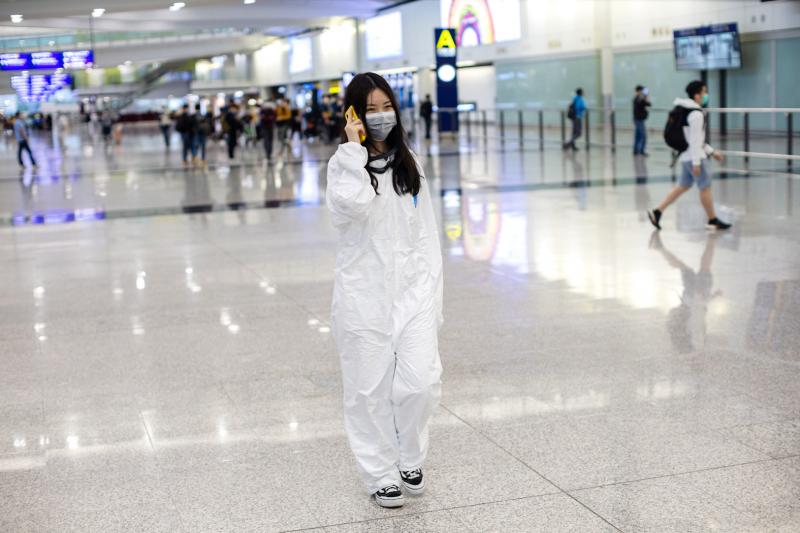Covid-19 has changed everything. In particular, it has changed everything about travel. As a Lonely Planet writer you learn fast that change is the only constant on the road. Still, no one was expecting the changes announced last week: that Lonely Planet is to close its Melbourne production facility and London offices “almost entirely,” as well as its magazine and Trade and Reference division. However, the famous guidebooks will continue to be published, though they are temporarily on hold.
As travel has outpaced the growth of the global economy for the last eight years, Lonely Planet has grown to become the world’s largest travel publisher, accounting for 31.5 percent of the global guidebook market.
But with planes grounded, borders closed and people quarantined, where travel is headed next is anyone’s guess.

Photo: AFP
“[It’s] a sad and difficult day for all of us in the Lonely Planet family,” wrote managing director of publishing, Piers Pickard.
END OF AN ERA
Certainly, the closure of Lonely Planet’s original headquarters in Melbourne is the end of an era. It was in Melbourne that co-founders Tony and Maureen Wheeler set up shop in 1973 after finishing their epic overland journey from London across Asia to Australia.

Photo: Bloomberg
They published an account of the journey in Across Asia on the Cheap, a stapled together volume featuring hand-drawn maps and the now-famous logo, designed by Tony. It sold 1,500 copies. Encouraged by its success, the Wheelers followed with guides to Nepal, Africa, New Zealand and New Guinea.
In 1977’s Africa on the Cheap, readers were advised to enjoy the “Bonadir weavers and old mosques” of Mogadishu, while a guide to the Middle East offered advice on hitch-hiking to Baghdad from Syria. But, it was the success of the 1981 India guide that put Lonely Planet in the backpacks of many young traveler hungry for foreign experiences.
“I remain proud of what Lonely Planet achieved,” says Tony Wheeler.

Photo: EPA-EFE
“I’m always delighted when people say, ‘I wouldn’t have gone there if LP hadn’t have given me a push, showed me the way.’”
Ryan Ver Berkmoes, the veteran writer, one-time Lonely Plant publisher and author of 130 guidebooks, describes the company under Tony and Maureen, as “the friend you wanted next to you at the bar in the country you’d just landed in. Full of smart, savvy advice so you could start having a great trip. It was a rollicking and amazing place where you made friends worldwide.”
I signed up in 1999 to research Ethiopia and — as with millions of other travelers — subsequent Lonely Planet trips provided foundational life experiences. I healed a broken heart researching the desert landscapes of Namibia. Years in Italy taught me to appreciate life’s simple pleasures. When my mother died, my grieving father joined me in Sicily. A working-class man who never traveled for pleasure, he was consoled by the cavalcade of treasures we saw. Last week, a friend phoned from Benghazi, Libya, to inquire about my health and safety — a poignant irony given that he now lives in a city run by militias.
While part of the company’s mission was undoubtedly to introduce readers to offbeat or struggling nations, Ver Berkmoes emphasizes the role Lonely Planet played in popularizing travel in people’s lives.
“It wasn’t just places like Libya, Burma (Myanmar) or Timor-Leste, there were few mainstream, widely available guidebooks for much of the planet” he says. “Lonely Planet helped take the foreign out of foreign travel.”
The company has also been a technology pioneer. There was a Lonely Planet blog in 1994, five years before the word “blog” was coined. A Web site followed, along with CitySync guidebooks on PalmPilots. Most innovative of all was the online traveler’s forum, Thorn Tree, launched in 1996. According to Jane Rawson, one of its first moderators: “A tiny Web team was set up and told to figure out what the Internet was and whether it was useful to travelers.”
In 2016, Lonely Planet’s online community topped 10 million. Social media, it turns out, was kind of a big thing.
But there has been upheaval and concern, too, including two company sales, first to the BBC in 2007 for 130 million pounds, then to US-based NC2 media in 2013 at the much-reduced price of 51.5 million pounds. Challenged by tough market conditions (guidebook sales fell 40 percent between 2007 and 2012, but have since recovered 27 percent) and online firms, such as Expedia, TripAdvisor and Google, the company sought to diversify into a multimedia business with TV, magazines, mobile apps, a blogging platform and e-commerce partnerships. Yet, through all this, Lonely Planet continues to finance multi-week research trips to update its guidebooks, and is now the only publisher that does so.
In many ways, the company’s fortunes mirror the evolution of mass tourism. In 1973, the year Lonely Planet was founded, the US budget airline Southwest turned its first profit and showed the reliability of low-cost air travel. Since then, tourism has increased as travel has become more accessible. In 2017, the UN World Tourism Organization estimated that the world might see 1.8 billion travelers by 2030. That was before Covid-19. Now, even Sir Stelios Haji-Ioannou of easyJet, the second largest budget airline in Europe, thinks his company will feel like a startup again once national lockdowns are lifted.
FUTURE OF TRAVEL
Asked where travel will go now, Tony Wheeler says: “I don’t think the current crisis is going to end the role of the traditional guidebook — whether it’s in print or digital. I’ve already got the new LP guidebooks for travels I had intended to make later this year.”
Ver Berkmoes also believes guidebooks will endure.
“Once we start traveling again so many old faces and brands will be gone,” he says. “People will need that friend next to them in the bar with loads of smart advice.”
He should know, as during his time at Lonely Planet he weathered two catastrophes that ravaged the travel industry — the 9/11 terrorist attacks in 2001 and the 2004 Boxing Day tsunami, which devastated large parts of Asia.
“The 9/11 attacks had a profound effect on the company. People stopped traveling and bookshops returned all their guidebooks,” says Ver Berkmoes. “The company lost dozens of talented people. It was wrenching for everyone. But travel did come back and so did Lonely Planet.”
In contrast, the tsunami galvanized the company to help in a huge humanitarian effort. The Wheeler’s donated relief funds and significant resources were deployed to assist where possible. “We had people on the ground in all the most affected areas and we scouted for projects that would make a difference,” says Ver Berkmoes. “There was a comprehensive part of the Web site that answered practical questions such as: how can I help? where should I travel? how do I get home?”
They are the same questions that many people are asking now, which is why the company’s commitment to its guidebooks is reassuring. If the future of travel looks more like the past — fewer trips with logistical challenges that are more carefully considered given new risks and uncertainty — then trustworthy travel information will be of great value. As I write, there are Lonely Planet writers emerging from lockdown in Beijing. They have a view of the road ahead.

The depressing numbers continue to pile up, like casualty lists after a lost battle. This week, after the government announced the 19th straight month of population decline, the Ministry of the Interior said that Taiwan is expected to lose 6.67 million workers in two waves of retirement over the next 15 years. According to the Ministry of Labor (MOL), Taiwan has a workforce of 11.6 million (as of July). The over-15 population was 20.244 million last year. EARLY RETIREMENT Early retirement is going to make these waves a tsunami. According to the Directorate General of Budget Accounting and Statistics (DGBAS), the

Many will be surprised to discover that the electoral voting numbers in recent elections do not entirely line up with what the actual voting results show. Swing voters decide elections, but in recent elections, the results offer a different and surprisingly consistent message. And there is one overarching theme: a very democratic preference for balance. SOME CAVEATS Putting a number on the number of swing voters is surprisingly slippery. Because swing voters favor different parties depending on the type of election, it is hard to separate die-hard voters leaning towards one party or the other. Complicating matters is that some voters are

Five years ago, on the verge of the first COVID lockdown, I wrote an article asking what seemed to be an extremely niche question: why do some people invert their controls when playing 3D games? A majority of players push down on the controller to make their onscreen character look down, and up to make them look up. But there is a sizable minority who do the opposite, controlling their avatars like a pilot controls a plane, pulling back to go up. For most modern games, this requires going into the settings and reconfiguring the default controls. Why do they

Take one very large shark, a boat (we’re gonna need a bigger one of those) and a movie that ran way over budget and you’ve got all the ingredients of a career-making film for one of Hollywood’s most successful directors. Now fans of Jaws — Steven Spielberg’s terrifying thriller about a man-eating shark — can re-live the movie as it celebrates its 50th anniversary in an exhibition at the Academy Museum in Los Angeles. “The film certainly cost me a pound of flesh, but gave me a ton of career,” Spielberg told reporters as he toured exhibits of props and memorabilia